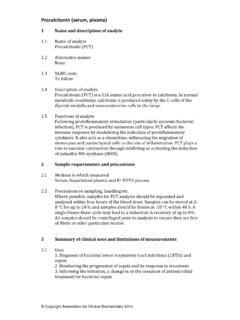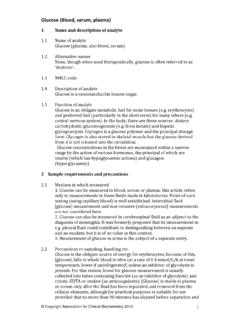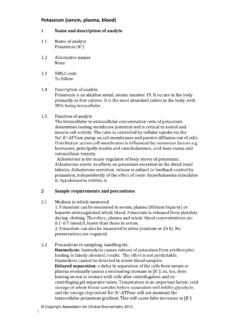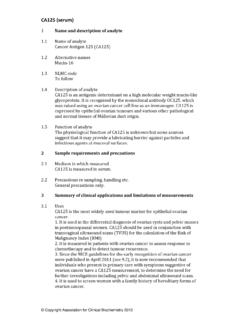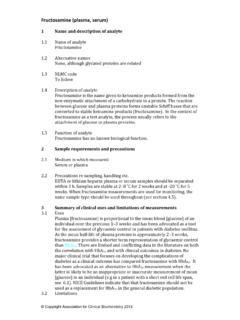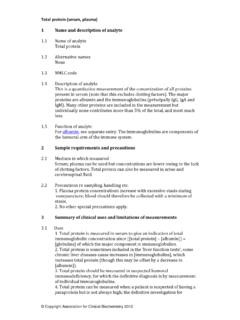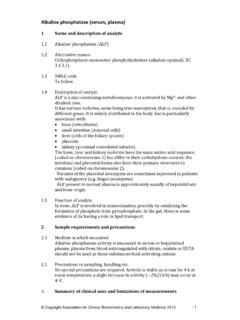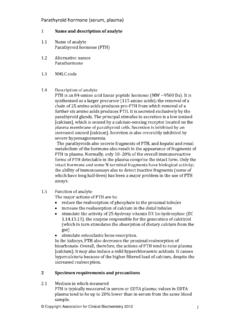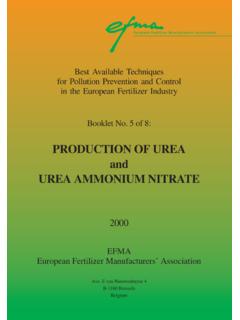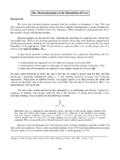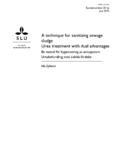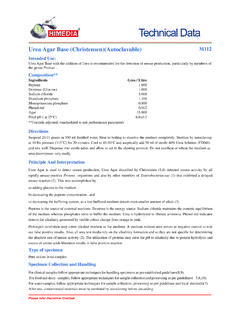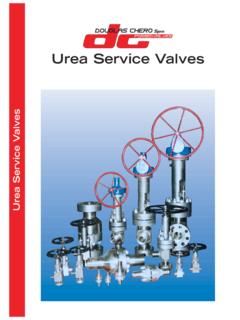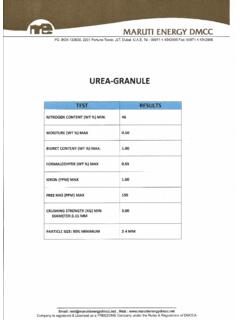Transcription of Urea (serum, plasma) - Association for Clinical ...
1 Copyright Association for Clinical Biochemistry 2012 urea ( serum , plasma ) 1 Name and description of analyte Name of analyte urea Synonyms There are several synonyms diaminomethanal, but in a medical context, this substance is always referred to as urea . NMLC code Description of analyte urea has the formula CO(NH2)2, MW 60 Da. It is synthesised by the reactions of the urea cycle from carbamoyl phosphate and ammonium ions, the latter being derived from deamination reactions. Function of analyte The formation of urea and its excretion by the kidneys represents the major route (~75%) by which surplus nitrogen is removed from the body. urea is an end product of metabolism: it does not participate in any synthetic reactions. In the kidneys, the contribution of urea to medullary hypertonicity is an important determinant of the ability of the kidneys to generate concentrated urine.
2 urea is recycled in this process but does not undergo any metabolic conversion. 2 Sample requirements and precautions Medium in which measured urea is usually measured in serum or plasma . The use of measurements of urea excretion in 24 h collections of urine as an index of urinary nitrogen excretion (for example, in the assessment of nitrogen balance) is flawed: the proportion of nitrogen excreted as urea shows considerable intra and inter individual variation. Precautions General precautions only. 3 Summary of Clinical uses and limitations of measurements Uses 1. urea has traditionally been measured as an index of renal function but has only limited value for this purpose (see ). Measurement of creatinine and calculation of estimated glomerular filtration rate (eGFR) is to be preferred, although it is not without its own limitations.
3 2. The widely used term urea and electrolytes refers to the measurement of (usually) serum urea , creatinine, sodium and potassium. The routine measurement of urea has an insubstantial evidence base and its inclusion in this profile is largely historical; circumstances in which its measurement may be clinically valuable are discussed in Copyright Association for Clinical Biochemistry 2012 Limitations plasma [ urea ] depends on the rate of its formation (hence nitrogen turnover) and the rate of its excretion. Although it is excreted largely by the kidneys (~10% is lost in sweat and through the gut), a variable quantity of filtered urea is reabsorbed so that the amount excreted does not accurately reflect the GFR. Particularly at low urine flow rates (as occur in dehydration) the proportion of filtered urea that is reabsorbed is increased, which may lead to an increase in plasma [ urea ] despite a normal GFR.
4 4 Analytical considerations Analytical methods 1. Chemical This formerly widely used method is based on the reaction of diacetyl (generated from diacetyl monoxime and acid) with urea to form diazine, which absorbs light at 540 nm. 2. Enzymatic These use urease ( urea aminohydrolase, EC ) to generate ammonia, which can be measured using various techniques. A method employing glutamate dehydrogenase (L glutamate:NAD(P) oxidoreductase (deaminating), EC ) is the most widely used. CO(NH2)2 + 2 H2O (urease) 2 NH4+ + CO32 NH4+ + 2 oxoglutarate + NADH + H+ (GDH) glutamate + H20 + NAD+ The consumption of NADH is monitored by measurement of absorbance at 340 nm. A more complex method has been developed in which a coloured chromogen is produced. The urease reaction with production of ammonia has been adapted for use in dry chemistry (including point of care) instruments, for example by employing an ion selective electrode to measure ammonium.
5 Reference method This is based on the urease and glutamate dehydrogenase reactions. Reference materials urea , SRM 909a; serum , SRM 912a (US National Bureau of Standards, Washington DC, USA). Interfering substances Endogenous ammonia is a potential interfering substance, but this is only likely to be a problem with high concentrations such as may occur in liver disease and certain inherited metabolic diseases. Sources of error The urease + glutamate dehydrogenase procedure is robust and not subject to significant error if analytical protocols are adhered to. 5 Reference intervals and variance Reference interval (adults): mmol/L, though this is dependent to some extent on dietary protein intake and lean body mass. plasma [ urea ] Copyright Association for Clinical Biochemistry 2012 tends to be higher with high lean body mass and dietary protein intake, and lower in asthenic individuals and those with a low protein intake ( vegetarians).
6 It also tends to increase with age. Reference intervals (others): slightly lower in children and during pregnancy. Extent of variation Interindividual CV: Intraindividual CV: Index of individuality: CV of method: Critical difference: 39% Sources of variation In addition to the influence of GFR, plasma [ urea ] is considerably affected by the rate of protein turnover, both exogenously determined (dietary protein intake) and endogenously determined ( being increased in catabolic states and by the absorption of amino acids from the gut following a gastrointestinal bleed). [ urea ] also depends on total body water status, in part because concentration is dependent on the volume of distribution of the solute, in part because of the effects of body water status on renal function.
7 6 Clinical uses of measurement and interpretation of results Uses and interpretation 1. Measurement of urea should not be used as a general test of renal function (see (1)). Circumstances related to renal disease in which it may be useful include: suspected pre renal renal failure due to fluid depletion or cardiac failure, when [ urea ] tends to rise before [creatinine] in monitoring the effects of renal replacement treatment ( urea kinetic modelling in which the function Kt/V is calculated (K = total urea clearance (mL/min), T = dialysis time (min), V = total body water (L)): the ideal value of Kt/V is > 2. Measurement of urea is of value in predicting the severity of acute pancreatitis (see (1)). 3. Suspected inherited metabolic disease plasma [ urea ] tends to be low in patients with urea cycle disorders, so that this finding may reinforce the need for further, more definitive, diagnostic tests in relevant Clinical circumstances.)
8 Confounding factors The interpretation of measurements of urea is confounded by its being influenced by three factors (see ): the rate of synthesis (reflecting protein turnover), the volume of distribution (effectively total body water) and the rate of excretion (determined by the rate of glomerular filtration and the (variable, according to urine flow rate) rate of tubular reabsorption. As a result, it may be difficult to ascribe a particular cause to an abnormal [ urea ], particularly if the abnormality is only slight. 7 Causes of abnormal results High values Causes Copyright Association for Clinical Biochemistry 2012 1. Renal failure The highest values are seen in established renal failure from any cause: concentrations may exceed 50 mmol/L in untreated renal failure (acute or chronic).)
9 [ urea ] does not help in differentiating acute from chronic renal disease. 2. Dehydration, low fluid intake excessive fluid loss, o vomiting, diarrhoea o excessive sweating o inappropriate treatment with diuretics o conditions causing polyuria (diabetes mellitus and insipidus). 3. Decreased renal perfusion, hypovolaemia systemic hypotension cardiac failure. 4. High protein turnover and generation of waste nitrogen, high muscle mass high protein intake gastrointestinal haemorrhage catabolic states, o trauma o sepsis o treatment with corticosteroids. Investigation Renal function should be investigated by Clinical measurements and observation (particularly related to fluid balance and hydration status). Measurement of serum creatinine will confirm impaired renal function except in early pre renal failure, when it may be normal.
10 Potassium should always be measured: hyperkalaemia is a frequent, and potentially lethal, complication of renal failure. Most of the other conditions listed above are diagnosed clinically. More than one cause may be contributory. Low values Causes Low values are uncommon; causes include: 1. Decreased protein turnover, low protein intake (including established, but not early, starvation) low body muscle mass. 2. Increased total body water, over hydration ( syndrome of inappropriate antidiuresis) pregnancy. 3. Decreased urea synthesis, inherited disorders of the urea cycle liver failure. Investigation The cause of a low [ urea ] will usually be obvious except in a sick child undergoing a protocol based panel of tests for suspected inherited metabolic disease (see (2)).
